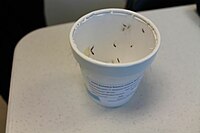
Photo from wikipedia
The first vaccines ever made were based on live-attenuated or inactivated pathogens, either whole cells or fragments. Although these vaccines required the co-administration of antigens with adjuvants to induce a… Click to show full abstract
The first vaccines ever made were based on live-attenuated or inactivated pathogens, either whole cells or fragments. Although these vaccines required the co-administration of antigens with adjuvants to induce a strong humoral response, they could only elicit a poor CD8+ T-cell response. In contrast, next-generation nano/microparticle-based vaccines offer several advantages over traditional ones because they can induce a more potent CD8+ T-cell response and, at the same time, are ideal carriers for proteins, adjuvants, and nucleic acids. The fact that these nanocarriers can be loaded with molecules able to modulate the immune response by inducing different effector functions and regulatory activities makes them ideal tools for inverse vaccination, whose goal is to shut down the immune response in autoimmune diseases. Poly (lactic-co-glycolic acid) (PLGA) and liposomes are biocompatible materials approved by the Food and Drug Administration (FDA) for clinical use and are, therefore, suitable for nanoparticle-based vaccines. Recently, another candidate platform for innovative vaccines based on extracellular vesicles (EVs) has been shown to efficiently co-deliver antigens and adjuvants. This review will discuss the potential use of PLGA-NPs, liposomes, and EVs as carriers of peptides, adjuvants, mRNA, and DNA for the development of next-generation vaccines against endemic and emerging viruses in light of the recent COVID-19 pandemic.
Journal Title: Vaccines
Year Published: 2021
Link to full text (if available)
Share on Social Media: Sign Up to like & get
recommendations!